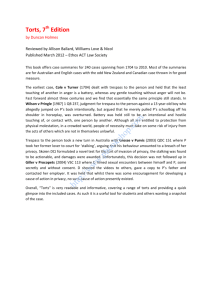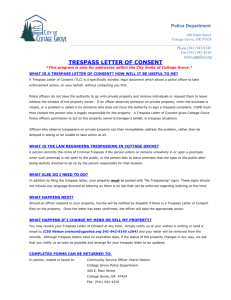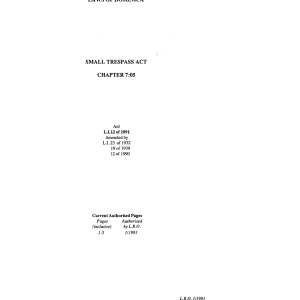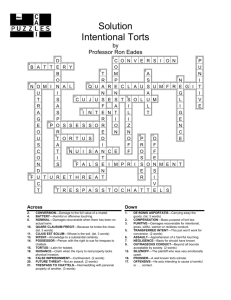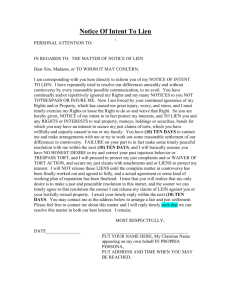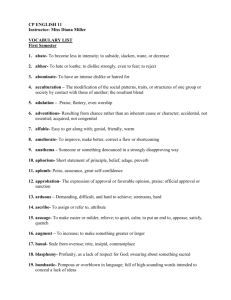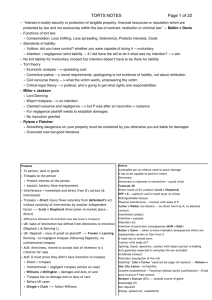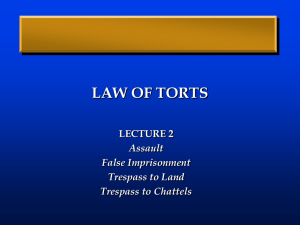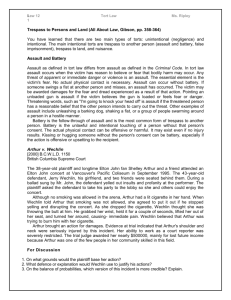A2 Law - HardleyLaw
advertisement
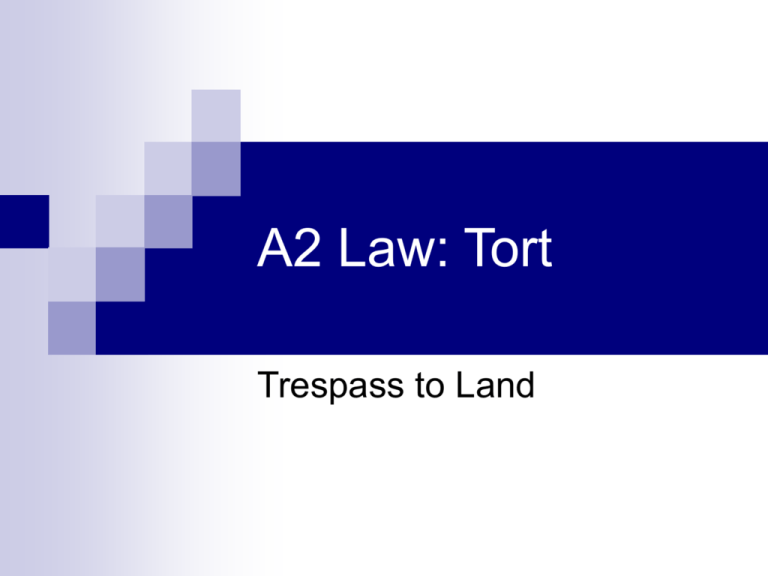
A2 Law: Tort Trespass to Land Definition Trespass to land occurs where a person directly enters upon another's land without permission, or remains upon the land, or places or projects any object upon the land. This tort is actionable per se without the need to prove damage. By contrast, nuisance is an indirect interference with another's use and enjoyment of land, and normally requires proof of damage to be actionable. THE WAYS IN WHICH TRESPASS MAY OCCUR 1. Entering upon land Walking onto land without permission, or refusing to leave when permission has been withdrawn, or throwing objects onto land are all example of trespass to land. For example, see Basely v Clarkson (1681) The D owned land adjoining C's, and in mowing his own land he involuntarily and by mistake mowed down some grass on the land of C 2. Trespass to the airspace Trespass to airspace above the land can be committed. Kelsen v Imperial Tobacco Co [1957] D committed trespass by allowing an advertising board to project eight inches into C's property at ground level and another above ground level. Note that s76(1) of the Civil Aviation Act 1982 provides that no action shall lie in nuisance or trespass by reason only of the flight of an aircraft over any property at a height above the ground which is reasonable. However, s76(2) confers a statutory right of action in respect of physical damage caused by aircraft, actionable without proof of negligence. 3. Trespass to the ground beneath the surface Bulli Coal Mining Co v Osborne [1899] The Ds mined from their land through to the C's land. This was held to be trespass to the subsoil. POSSESSION OF LAND This tort developed to protect a person's possession of land, and so only a person who has exclusive possession of land may sue. Thus, a landlord of leased premises does not have exclusive possession, nor does a lodger or a licensee. However, a tenant or subtenant does (Street v Mountford [1985] CONTINUING TRESPASS A continuing trespass is a failure to remove an object (or the defendant in person) unlawfully placed on land. It will lead to a new cause of action each day for as long as it lasts: Holmes v Wilson and others (1839) Konskier v Goodman Ltd (1928) For example, in Holmes v Wilson and others (1839) the Ds built supports for a road on C's land. The Ds paid damages for the trespass, but were held liable again in a further action for failing to remove the buttresses. MISTAKEN OR NEGLIGENT ENTRY Trespass to land is an intentional tort. However, intention for the act is required, not an intention to trespass. Consequently, deliberate entry is required and lack of knowledge as to trespass will not be a defence (Conway v George Wimpey & Co [1951]) Mistaken entry In Basely v Clarkson (1681), the D owned land adjoining C's, and in mowing his own land he involuntarily and by mistake mowed down some grass on the land of C. Involuntary entry An involuntary trespass is not actionable: Smith v Stone (1647), where D was carried onto the land of C by force and violence of others; there was trespass by the people who carried D onto the land, and not by D. Negligent entry A negligent entry is possible and was considered in League Against Cruel Sports v Scott [1985]. The Cs owned 23 unfenced areas of land. Staghounds used to enter the land in pursuit of deer. The Cs sued the joint Masters of the Hounds for damages and sought an injunction against further trespasses. Park J issued an injunction in respect of one area restraining the defendants themselves, their servants or agents, or mounted followers, from causing or permitting hounds to enter or cross the property. Damages for six trespasses were awarded. The judge said: "Where a master of staghounds takes out a pack of hounds and deliberately sets them in pursuit of a stag or hind knowing that there is a real risk that in the pursuit hounds may enter or cross prohibited land, the master will be liable for trespass if he intended to cause the hounds to enter such land or if by his failure to exercise proper control over them he causes them to enter such land." Defences Licence A licence is a permission to enter land and may be express, implied or contractual. A dictionary definition is as follows: "In land law, a licence is given by X to Y when X, the occupier of land, gives Y permission to perform an act which, in other circumstances, would be considered a trespass, e.g., where X allows Y to reside in X's house as a lodger. A bare licence is merely gratuitous permission. A licence may be coupled with an interest, as where X sells standing timber to Y on condition that Y is to sever the timber; in this case the sale implies the grant of a licence to Y to enter X's land….." (LB Curzon, Dictionary of Law, Fourth Edition). If a licensee exceeds their licence, or remains on the land after it has expired or been revoked, the licensee becomes a trespasser (Wood v Leadbitter (1845); Hillen v ICI (Alkali) Ltd [1936]. Such a person is allowed a reasonable time in which to leave (Robson v Hallett [1967]; Minister of Health v Bellotti [1944]). There is also the defence of estoppel by acquiescence, that is, consent which is expressed or implied from conduct, eg, inactivity or silence (Jones v Stones [1999] - mere delay in complaining is not acquiescence). Rights of entry A person may exercise a lawful right of entry onto land, for example: · A private right of way granted to the defendant; · A public right of way; · A right given by the common law, such as the right to abate a nuisance; and · A right of access given by statute, such as ss16-18 PACE 1984, the Access to Neighbouring Land Act 1992 and s8 of the Party Wall Act etc. Act 1996. REMEDIES Remedies include: · Damages (which will be nominal if there is only slight harm to land). · An injunction to prevent further acts of trespass (at the discretion of the court). · An action for the recovery of land if a person has been deprived of lawful possession of the land (formerly known as ejectment). Note 1: an action cannot be brought to recover land after the expiration of twelve years from the date on which the right of action accrued: s15 of the Limitation Act 1980. Note 2: the procedure for the removal of squatters is now contained in schedule 1 of the Civil Procedure Rules (previously RSC Ord. 113), and a residential occupier cannot be evicted by a landlord without a court order under the Protection from Eviction Act 1977. · An action for mesne profits, to recover damages for loss during a period of dispossession (Inverugie Investments Ltd v Hackett [1995] 3 All ER 841, 846 per Lord Lloyd). · Right of entry, ie the right of resuming possession of land by entering. Note 1: A lease may give the lessor the right to re-enter on a breach of covenant by the lessee but the right is not enforceable unless and until notice is served on the lessee under s146 of the Law of Property Act 1925. Note 2: It is unlawful to enforce a right of re-entry, except through court proceedings, while the occupier is lawfully residing in the premises: s2 Protection from Eviction Act 1977.

